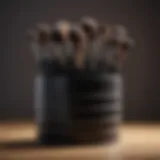Effective Natural Ways to Remove Facial Hair Permanently


Intro
Facial hair is a common issue that can affect self-esteem and personal image. For many individuals, the hassle of frequent shaving or other temporary methods can leave one yearning for something more long-lasting and effective. In a world increasingly leaning towards natural remedies, the quest for permanent facial hair removal methods has gained traction. This guide dives deep into effective natural solutions that can offer a smooth complexion without resorting to commercial products or harsh treatments.
In this exploration, we will look at various methods, discuss the ingredients involved, and share practical tips that not only consider physical removal but also touch on lifestyle changes. Our goal is to provide insight and knowledge to help one navigate through these options with confidence and understanding.
Natural Ingredients for Facial Hair Removal
When it comes to addressing unwanted facial hair through natural means, certain ingredients stand out. Here are some of the notable ones that have proven beneficial:
- Turmeric: Known for its anti-inflammatory properties, turmeric can help slow hair growth and can be easily made into a paste with water or milk.
- Sugar and Lemon Juice: This dynamic duo works well in a homemade wax. The sugar acts as an exfoliant, while lemon juice helps lighten the hair over time.
- Gram Flour: Mixed with water or yogurt, this ingredient can provide both exfoliation and hair removal benefits, generally used as a mask.
- Potato Juice: Rich in enzymes, potato juice can aid in hair reduction, especially when applied consistently.
"Natural solutions often require patience, but persistence can yield satisfying results."
Each of these ingredients has a history rooted in tradition, often used across cultures for various beauty rituals.
Techniques for Application
Once you’ve chosen your ingredient, knowing how to apply it is key. Here are some steps you might follow:
- Preparation: Start by cleansing your face to remove oils or dirt. A clean slate aids absorption and effectiveness.
- Mixing: For instance, if you are using sugar and lemon juice, mix them into a thick paste, ensuring the sugar is adequately wet but not overly runny.
- Application: Use a clean brush or your fingers to apply it to the desired area, following the hair's growth direction.
- Timing: Let the mixture sit for about 20-30 minutes, allowing the ingredients to penetrate the skin.
- Removal: Gently rinse it off with warm water, using circular motions to eliminate the mixture and exfoliate the skin.
Lifestyle Adjustments
Sometimes, beauty doesn’t just come from products but from holistic changes in lifestyle. Consider these adjustments to complement your natural hair removal efforts:
- Diet: Incorporating a balanced diet rich in vitamins can support healthier skin and hair properties. Foods packed with vitamins B, D, and E may help.
- Hydration: Drinking enough water ensures your skin stays supple and can support your skin’s health.
- Skincare Routine: Adopting a consistent skincare routine that includes exfoliation will help maintain smooth skin, making hair removal easier.
Closure
With natural methods, remember that consistency is key. It may take time to see the full results, but the best things are worth the wait. Stay informed and don’t hesitate to explore what works best for your unique skin and hair type!
Understanding Facial Hair Growth
Understanding the growth of facial hair is crucial for individuals looking to manage it effectively. Many people experience various challenges when it comes to unwanted hair, and knowing the underlying causes of facial hair growth can make a significant difference in selecting suitable removal methods. When one understands what influences hair growth, it becomes easier to tailor a personal hair removal strategy that suits their needs and preferences.
The relevance of this section also extends to debunking myths that may cloud one’s judgment, as misinformation often leads to ineffective treatments. Consequently, this helps to shed light on the various natural and permanent solutions available, encouraging informed decision-making.
What Causes Facial Hair Growth?
Facial hair growth is generally influenced by a variety of factors. Hormones play a significant role, particularly androgens like testosterone. These hormones are more prevalent in men, but women also produce them. Hormonal balance is critical; any shifts can lead to increased hair thickness and growth.
Here are some key factors that contribute to facial hair growth:
- Genetics: If female relatives have noticeable facial hair, likelihood rises that one might too, indicating a genetic predisposition.
- Hormonal Imbalances: Conditions like polycystic ovary syndrome (PCOS) can cause higher levels of male hormones, leading to increased facial hair.
- Age: Hormonal changes during puberty and menopause can affect hair growth patterns.
- Medical Conditions: Certain disorders might stimulate hair growth, making it crucial to consult with a healthcare provider if rapid growth is noticed.
Common Myths About Facial Hair
Several myths about facial hair can complicate a person's relationship with their body image. Here are some common misconceptions:
- Shaving Makes Hair Grow Back Thicker: Many believe shaving causes hair to grow back thicker and coarser. In reality, shaving simply cuts hair at the surface, and because it’s blunt, it may appear thicker when it grows back.
- Hair Growth Is Directly Related to Nutrition: While a balanced diet is essential for overall health, simply eating certain foods won't drastically change hair growth patterns.
- All Hair Removal Techniques Cause Darker Growth: Not all hair removal methods contribute to thicker hair. Methods like threading and waxing can reduce hair growth over time.
Understanding these myths can free individuals from anxiety and enable more rational decisions about managing their facial hair. Going forward, focusing on natural remedies backed by science and lifestyle changes offers promising avenues for effective hair reduction.
Natural Methods for Reducing Facial Hair
Facial hair can be a bit of a thorn in the side for many individuals. Whether it’s a few stray strands or thicker patches, the desire for silky smooth skin is a common thread among us. Delving into natural methods can make this quest not only simpler but also gentler on the skin. These methods don’t just aim for hair removal; they often enhance overall skin health. In this section, we’ll explore various techniques that provide effective results without going the commercial route.
Exfoliation Techniques
Exfoliation is a cornerstone of skincare. It's the process of removing the dead skin cells from the surface of the skin, which, let’s face it, can make a world of difference when it comes to appearance and texture. Regular exfoliation not only helps keep your skin fresh but can also impact facial hair growth, making methods like these worthwhile.
Physical Exfoliation
Physical exfoliation employs the use of scrubs, brushes, or tools to manually remove dead skin cells. Think of it as giving your skin a little workout. The key characteristic here is the immediate feedback you get – the roughness of a scrub or a brush can instantly smooth the skin. This can help in reducing the appearance of hair and make it less noticeable. It’s a widely liked option because it’s quite straightforward; you usually mix some granules with your favorite base, and voilà, you scrub away!
Advantages of Physical Exfoliation:
- Instant results
- Increased blood circulation, promoting healthier skin
Disadvantages:


- Risk of skin damage if used excessively
- Might not be suitable for sensitive skin issues
Chemical Exfoliation
On the other hand, there’s chemical exfoliation. This method uses acids or enzymes to dissolve the bonds holding dead skin cells together. A popular choice among skincare aficionados, chemical exfoliation can penetrate deeper than physical methods.
The key characteristic of chemical exfoliation is its ability to be gentle on the skin while still delivering impressive results. Lactic acid and glycolic acid are common culprits here, known for how effectively they can smoothen out the skin without harsh scrubbing.
Advantages of Chemical Exfoliation:
- Gentle yet deep-cleansing effect
- Improved skin texture over time
Disadvantages:
- Can lead to sensitivity, particularly in sunlight
- Requires careful application to avoid irritation
Herbal Remedies
Herbal remedies offer a blend of tradition and holistic care, often harnessing the power of nature to combat facial hair. They’re not just about hair removal but also about nourishing the skin.
Turmeric Paste
Turmeric, with its golden hue and robust properties, serves more than just a culinary role. Turmeric paste is often touted as a strong contender against unwanted hair. The active ingredient, curcumin, is believed to slow down hair growth. Not only that, but it also helps soothe inflammation and brightens the skin.
A unique feature of using turmeric paste is its historical perspective; practiced in many cultures for centuries, it often yields positive testimonials. However, keep in mind that turmeric can stain, so a little caution goes a long way.
Advantages of Turmeric Paste:
- Natural ingredient with anti-inflammatory properties
- Potential long-term reduction of hair growth
Disadvantages:
- Stains skin temporarily, can be messy to apply
- May require multiple applications for noticeable results
Lentil and Rose Water Combination
Equally intriguing is the lentil and rose water combination. Lentil powder is fine and gentle, and when mixed with rose water, it transforms into a paste that can be applied to the skin. Rose water is not only refreshing but adds a soothing aspect that complements the exfoliating power of lentils.
This concoction offers a unique mix: the lentils help remove the hair, while rose water hydrates and calms the skin, making it ideal for those postpartum glow-ups. While it might not yield instant results, over time, many have sworn by its effectiveness in reducing the appearance of hair.
Advantages of Lentil and Rose Water Combination:
- Gentle yet effective, suitable for sensitive skin
- Hydrating and soothing effects from rose water
Disadvantages:
- Requires consistent use for visible effects
- Might be less effective on thick hair
In closing, these natural methods emphasize a gentle, sustainable approach to managing facial hair. By incorporating regular exfoliation and selecting the right herbal remedies, individuals can take a step towards smoother skin that feels as good as it looks.
Dietary Influences on Hair Growth
Understanding how diet impacts facial hair growth can be a real eye-opener. The food we consume can have a significant effect on our skin's health and appearance. Certain nutrients either promote healthy hair growth or contribute to unwanted hair proliferation. Therefore, for anyone curious about achieving smooth skin or managing facial hair effectively, this segment is fundamental.
Foods that Promote Healthy Skin and Hair
Omega-3 Fatty Acids
Omega-3 fatty acids play a crucial role in maintaining skin health and can influence hair growth. These fats are renowned for their anti-inflammatory properties, which can aid in soothing irritated skin. Moreover, they help in keeping skin hydrated by fortifying the skin barrier.
The key characteristic of Omega-3s is their ability to improve circulation, which is essential for nutrient delivery to hair follicles. This strengthened blood flow can encourage healthier hair growth and reduce excess facial hair due to hormonal imbalances.
Its unique feature lies in the fact that Omega-3s can be derived from both animal and plant sources, such as fish, flaxseeds, and walnuts. Including these in your diet can create a powerful ally in promoting overall skin health.
Despite their many benefits, it's important to manage the intake of Omega-3s to avoid excessive calorie consumption, as not all fats are created equal.
Vitamins and Minerals
Vitamins and minerals are another cornerstone of maintaining healthy skin and managing facial hair. Vitamins A, C, D, and E, as well as B-complex vitamins, are particularly vital. For instance, Vitamin A supports cell turnover, promoting new skin cells, while Vitamin C aids in collagen formation for skin elasticity.
The unique aspects of vitamins and minerals are that they work synergistically; they enhance each other’s absorption and effectiveness. A deficiency in these nutrients can lead to various skin issues, including excess hair growth and poor hair quality.


For those seeking natural methods for hair removal and skin care, consuming a balanced diet rich in these vitamins can deliver a significant impact. However, excessive intake of certain vitamins, particularly fat-soluble ones like A and D, can lead to toxicity, so moderation is key.
Foods to Avoid
Processed Sugars
Processed sugars can cause spikes in insulin levels, leading to increased sebum production and, by extension, potential hair growth. High sugar intake is often linked to various skin issues, including acne, which can agitate existing facial hair concerns.
The detrimental aspect of processed sugars is how frequently they’re included in everyday diets, hidden in many beverages and snacks. This creates a challenge for individuals looking to reduce unwanted hair growth through diet.
Eliminating or at least minimizing these sugars can contribute to better skin clarity and an overall healthier appearance. It’s advised to favor natural sweeteners like honey or fruits whenever possible to avoid the negative effects of refined sugars.
Dairy Products
Dairy products have been shown in some studies to affect hormone levels, particularly androgens, which can influence hair growth. The consumption of milk, cheese, and other dairy items can lead to increased production of hormones that may exacerbate facial hair issues, especially in women.
A distinguishing characteristic of dairy is that it can be both a good source of calcium and protein but also a trigger for unwanted hormonal reactions. This makes it something to approach with caution.
While dairy can be part of a balanced diet for many, those particularly sensitive to its effects may find it beneficial to limit intake and explore alternatives, like almond or oat milk.
"Dietary changes can be simple yet effective in addressing unwanted hair growth—what you eat matters!"
Lifestyle Changes for Long-Term Results
Making changes in your lifestyle can have a big impact on personal wellbeing, and this includes facial hair management. It’s not just about cutting down hair; lifestyle adjustments can positively influence hair growth patterns and skin health over time. With a consistent focus on stress management and skincare practices, individuals may find they can reduce facial hair growth more effectively than with short-term measures alone.
Stress Management
Stress, often dubbed as the silent killer, can have adverse effects on various bodily functions, including hair growth. When the body goes through elevated stress levels, it can disrupt hormonal balance, leading to increased facial hair. Thus, managing stress is not just a mental health endeavor, but a critical part of any facial hair removal strategy.
Mindfulness Practices
Mindfulness practices, such as meditation or deep-breathing exercises, focus on bringing awareness to the present moment. These techniques can help calm the mind and body, reducing stress levels that may contribute to unwanted hair growth.
One of the notable features of mindfulness is its simplicity. It doesn’t require special tools or extensive time commitments. Just a few minutes a day can make a significant difference. This makes it a highly accessible choice for those seeking holistic approaches.
However, while mindfulness holds numerous advantages, it’s essential to remember that results might not come overnight. Some find this gradual change in mindset and stress levels frustrating, but patience plays a vital role in the process.
Physical Activity
Engaging in regular physical activity is another cornerstone for better stress management. Exercise isn't just about staying fit; it boosts the production of endorphins—those feel-good hormones that naturally lower stress.
The key characteristic of physical activity lies in its versatility. Whether through brisk walking, yoga, or cycling, there’s something for everyone. This inclusivity makes it a commendable strategy in any lifestyle change plan.
It's worth mentioning that while exercise works wonders, it can sometimes feel like a chore. The trick lies in finding an activity that doesn't feel like work, ensuring that it becomes a habitual part of life.
Skin Care Routine Adjustments
A well-balanced skincare routine is another important facet in the quest for smooth skin. Keeping skin moisturized and protected can reduce irritation and promote healthier hair follicles. This ultimately aids in a more effective removal process.
Moisturizing Techniques
Applying moisturizers regularly helps keep the skin hydrated and nourished. This aspect is critical because hydrated skin is generally healthier and more resilient, which means it can handle hair removal processes more effectively.
Various moisturizing techniques, like applying lotions or oils, can suit different skin types. For instance, individuals with dry skin might benefit from thicker creams, while oily skin types could lean towards lightweight gels. Finding the right product avoids clogging pores and potential hair growth issues. Although moisturizing is often over-looked, its impact is profound.
Usage of Sunscreen
The usage of sunscreen is another essential adjustment. Daily protection against UV rays prevents skin damage and helps maintain an even skin tone. This is particularly relevant for women of all ages, as skin health can significantly influence hair growth patterns.
Sunscreen protects the skin and acts as a barrier against environmental stressors, thus contributing to overall skin vitality. Selecting the right SPF is crucial, especially for different skin tones and types. Although some might find daily usage tiresome, incorporating it into a routine can reap long-term benefits.
Ultimately, adopting a lifestyle that emphasizes stress management and skincare adjustments can lead to more permanent solutions for dealing with facial hair. With time and consistency, these methods can effectively contribute to achieving smoother skin.
Advanced Natural Treatments
When it comes to facial hair removal, many individuals are on the lookout for effective and natural approaches that won't harm their skin or lead to unwanted side effects. Advanced natural treatments have gained significant traction as these methods blend traditional practices with modern understanding of skincare. The goal is simple: to reduce facial hair growth over time while promoting overall skin health. These techniques, particularly laser treatments and electrolysis, offer promising pathways to achieving smooth skin without the drawbacks often associated with commercial products.
Laser Techniques Explained
How Laser Treatment Works


Laser hair removal utilizes targeted light energy to damage hair follicles, making it a popular choice for those seeking to lessen facial hair permanently. The process involves the application of highly concentrated light beams, which are absorbed by the pigment in the hair follicles. This makes it effective for individuals with darker hair against lighter skin tones, as the contrast enables better targeting. The key characteristic here is precision—the laser can selectively damage hair follicles while sparing the surrounding skin.
One unique aspect of laser treatment is its ability to treat large areas quickly, making it efficient for both small and larger patches of unwanted hair. Many patients report long-lasting results after just a few sessions, underscoring its appeal as a viable solution for regular facial hair issues. However, it is worth noting that results can vary greatly among individuals, depending on hair type and thickness.
Pros and Cons of Laser Hair Removal
As with any treatment, laser hair removal comes with its own set of advantages and disadvantages. The pros include:
- Long-lasting results after a series of treatments, with some individuals achieving permanent reduction in hair growth.
- Quick sessions, where larger areas can be treated in less time compared to traditional methods like waxing or shaving.
- Minimal downtime, allowing individuals to return to their daily routines with minimal interruption.
On the flip side, there are cons to consider:
- It can be costly, with multiple sessions required for desired results.
- Risk of skin irritation or discoloration, particularly in sensitive areas.
- The effectiveness can be limited for individuals with light-colored hair or darker skin tones, due to variations in pigment absorption.
Electrolysis: A Viable Option
Understanding Electrolysis
Electrolysis stands out as the only FDA-approved method for permanent hair removal. Unlike laser treatments, which target the hair pigment, electrolysis employs an electric current transmitted through a very fine needle inserted into each hair follicle. This process destroys the follicle's ability to produce hair, making it a highly effective permanent solution. A key characteristic of electrolysis is its adaptability, as it works on all hair colors and skin types.
One unique feature of electrolysis is its precision; since each hair is treated individually, it’s both a meticulous and time-consuming process. Clients often appreciate the control it offers, as they can decide how much hair to remove at once. However, that precision comes with the caveat of requiring numerous sessions for optimal results, which can be somewhat of a commitment.
Long-term Effectiveness
The long-term effectiveness of electrolysis is one of its standout features. Once a follicle has been successfully treated, it’s unlikely that hair will grow back. This offers considerable peace of mind to those fed up with the recurring cycle of other hair removal methods. Particularly for individuals with stubborn areas of facial hair, electrolysis can deliver a dependable result over time.
However, commitment is essential since it can take multiple visits to achieve full hair removal. The meticulous nature of the procedure also means that clients can expect some level of discomfort. Thus, it’s important for potential users to weigh the benefits against their own lifestyle needs and pain tolerance.
"Investing in advanced natural treatments not only enhances beauty but also promotes self-confidence."
In summary, advanced natural treatments like laser hair removal and electrolysis provide effective alternatives to traditional facial hair removal methods. Each approach has its own set of advantages and considerations; understanding these can help individuals make informed decisions aligned with their personal needs and preferences.
Potential Side Effects of Natural Remedies
When considering natural methods for facial hair removal, it's essential to weigh the potential side effects these remedies might bring about. Natural solutions are often perceived as safer alternatives compared to chemical products or invasive treatments, but they aren't free from risks. Understanding these risks can empower individuals to make informed choices about their skincare routines, ensuring they can achieve their desired outcomes without unwanted complications.
Skin Reactions to Herbal Treatments
Herbal treatments often strike a chord with people seeking holistic solutions for facial hair removal. However, the skin can be quite sensitive to some natural ingredients. For example, turmeric, known for its anti-inflammatory properties, can cause skin irritation or yellow staining. The same goes for other herbs like neem and aloe vera, which, while widely praised for their benefits, can provoke adverse reactions in individuals with sensitive skin.
It's crucial to conduct a patch test before diving headfirst into any herbal remedies. Apply a small amount of the treatment to your wrist or behind your ear and monitor for signs of redness, itching, or swelling. This simple test can save you from a world of hurt. Building knowledge around your skin's reactions can help determine which treatments are beneficial and which to steer clear of.
Other Concerns
Allergies
When incorporating natural solutions into your beauty routine, allergies can play a notable role in the effectiveness of herbal remedies. Some individuals may find themselves allergic to certain plants, leading to skin rashes or even more severe reactions. For instance, chamomile, often heralded for its calming effects, can trigger allergic responses in people sensitive to ragweed. This aspect is a double-edged sword: while natural treatments offer a gentler approach, the possibility of allergic reactions cannot be overlooked.
Being aware of personal allergies and doing thorough research on each ingredient is essential. Options that resonate universally may not apply to everyone, making individualized care paramount. The key characteristic of this aspect is that while one remedy might work wonders for another person, it could spell trouble for you. Hence, always approach with caution and seek alternatives if needed.
Ineffectiveness
One must also consider the ineffectiveness of some natural remedies. Despite the hope that certain treatments will yield results, many may not deliver the promised effects, leading to frustration and wasted time. Ingredients like sugar and lemon juice are often touted for their hair removal qualities, but results can vary drastically from person to person. What works as a charm for one may not work at all for another, leaving users disappointed.
This brings about the importance of managing expectations. Natural remedies can be hit or miss, and establishing realistic goals is crucial. The unique feature here is that while compiling a list of notable natural remedies, the inconsistency in effectiveness highlights their varied responses. Thus, remaining adaptable and willing to try different approaches can be beneficial in your journey toward smoother skin.
"Understanding the potential side effects of natural remedies allows for a more tailored and safe approach to facial hair removal, fostering confidence in personal care choices."
Knowledge of these side effects not only contributes to safer application but also enhances the overall understanding of how one's skin interacts with natural products in the long run. Focusing on individual responses and being prepared for a journey rather than an overnight solution can lead to a more rewarding outcome.
Summary and Epilogue
In this article, we have traversed the intricate landscape of facial hair removal, focusing specifically on natural and permanent solutions. This topic holds immense significance, as it addresses common concerns shared by many, especially women of various ages who seek smooth skin and self-confidence.
The exploration began with understanding the dynamics of facial hair growth. By digging into the causes, we provided a solid foundation for our readers to comprehend why certain methods may work better than others. Through this realization, individuals can make informed decisions that best suit their specific situations.
Then, we delved into natural methods for reducing facial hair, such as exfoliation techniques and herbal remedies. These approaches promote not only facial hair removal but also skin health, showing that beauty can stem from the gifts of nature. It’s critical that readers appreciate these organic solutions as more than mere trends; they potentially serve as long-term methods when practiced consistently.
When discussing dietary influences, we identified key foods that promote healthy skin and hair, while also highlighting those that one should steer clear of. Nutrition, it seems, plays a pivotal role in regulating hair growth. This connection cannot be underestimated, as a balanced diet could be the secret weapon in achieving desired outcomes.
Lifestyle changes were also addressed, emphasizing stress management and proper skin care routines. These factors intertwine closely with hormonal balance and skin health. By making simple yet impactful adjustments, readers can foster an environment that naturally minimizes unwanted hair growth.
We also examined advanced natural treatments, such as laser techniques and electrolysis. While these methods introduce a technological touch to natural solutions, it’s essential to weigh the pros and cons of each. This awareness fosters a better understanding of what procedures might align with personal values and health goals.
The discussion of side effects, particularly those associated with natural remedies, is crucial as well. By shedding light on potential skin reactions and allergies, readers can navigate their choices with greater caution, ensuring they achieve their desired results without adverse consequences.
"The journey to achieving smooth skin is multifaceted, encompassing knowledge, awareness, and dedicated effort."







